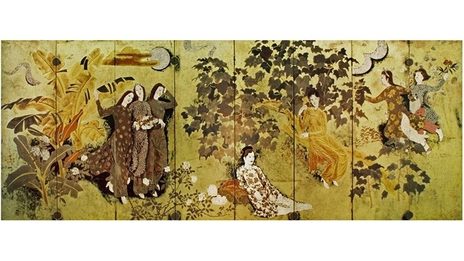The fine arts and photography sector are working on two projects, ‘Vietnamese lacquer art’ and ‘Vietnam’s city of photography’, in order to turn the country’s two forms of art into national trademarks.
(News) - The fine arts and photography sector are working on two projects, ‘Vietnamese lacquer art’ and ‘Vietnam’s city of photography’, in order to turn the country’s two forms of art into national trademarks.

A lacquer painting entitled Thieu Nu Trong Vuon (Girls in The Garden) by master painter Nguyen Gia Tri. (Photo courtesy of the Vietnam Museum of Fine Arts).
The two projects were developed by the Department of Fine Arts, Photography and Exhibition (DFPE), as assigned by the Ministry of Culture, Sports and Tourism, in an effort to realise the Prime Minister-approved strategy on developing Vietnam’s cultural industries by 2020 with a vision to 2030.
The DFPE has decided to focus on fine arts and photography – two fields in which Vietnam holds many advantages, in order to create quality products which are good enough to feasibly be consumed in both domestic and foreign markets, thus contributing to advertising Vietnam’s land and people to the world.
As a time-honoured genre of Vietnam’s art, lacquer art has been practiced by many generations of artists and has established its fame in regional arts and international markets.
The project on ‘Vietnamese lacquer art’ formulates a set of criteria and standards for the material of lacquer, the production procedure, and required techniques to make lacquer paintings and products become a national trademark.
The project also maps out plans and activities to turn Vietnam into a centre for the art of lacquer through the organisation of workshops, seminars and performances featuring lacquer; tours and trade fairs to provide first-hand experience about the craft of lacquer making; and exhibitions and displays of Vietnamese lacquer products.
These activities are expected to boost the development of lacquer, expand markets for the products and further promote them to customers at home and abroad.
In addition, the planting area of lacquer trees (Rhus verniciflua) will be restored under the project to improve the material shortage which is facing Phu Tho Province.
Meanwhile, the ‘Vietnam’s city of photography’ project presents its first-ever model of event organisation. Accordingly, selected cities and provinces which have strong advantages in tourism and possess rich culture will biennially host a series of photography events.
According to Head of DFPE Vi Kien Thanh, the project plans the organisation of a fair on introducing and trading products and supporting equipment for photographers during field trips, whose works will be sold at the following event, together with seminars, workshops and exchange events on photography.
The Department is considering two options on whether such events will be held by localities on a rotating basis or if they will take place in a fixed location.
The project is expected to encourage creative thinking; develop in-depth and professional photography in Vietnam; and contribute to raising public awareness about the possession and use of photographic works.
Fine arts and photography is the first out of five industries that are tasked with developing its own national trademark under the guidelines of the Ministry of Culture, Sports and Tourism, with the four remaining industries including tourism, cinema, performing arts, and advertisement.
Functional agencies have carried out further research and organised consultation workshops and field trips to collect opinions from experts, managers and artists about the two projects.
Deputy Head of the Science and Technology Department under the MoCST Vo Viet Doan stated that cooperation and mutual support between the Ministry of Industry and Trade, the Ministry of Information and Communications, the Vietnam Fine Arts Association, the Vietnam Association of Photographic Artists, press agencies and media are needed to finalise the projects.
Source: Nhandan